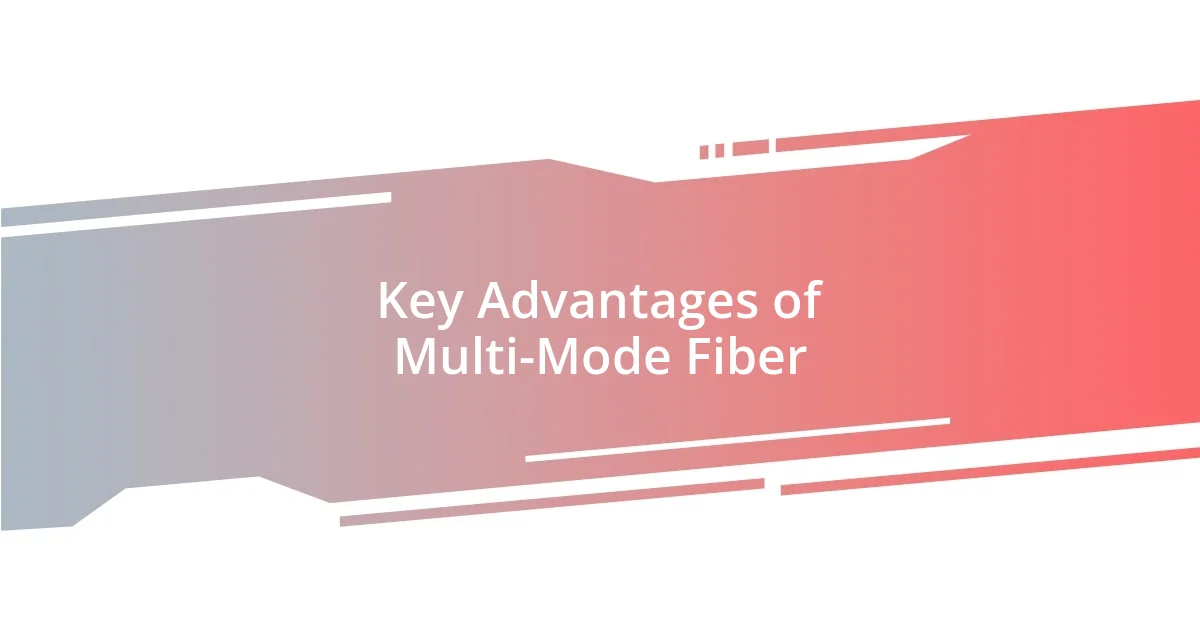Key takeaways:
- Multi-mode fiber (MMF) enhances data transmission over short distances with a larger core diameter, making it ideal for high-bandwidth applications.
- The main types of multi-mode fiber—OM3, OM4, and OM5—vary in bandwidth and distance capabilities, influencing network performance and future scalability.
- Successful installation and troubleshooting of MMF require attention to detail, including checking for physical damage, ensuring proper connector seating, and utilizing optical power meters for diagnostics.

Introduction to Multi-Mode Fiber
Multi-mode fiber (MMF) is a fascinating technology that has transformed how we transmit data. I remember the first time I encountered multi-mode fiber during a project at work. The sheer speed and efficiency compared to traditional copper wires left me in awe. Have you ever tried running a marathon, only to find out your friend is coming in much faster? That’s exactly how I felt witnessing the advantages of multi-mode fiber in action.
It’s important to understand that MMF supports multiple light modes, which allows for improved data transmission over relatively short distances. In my experience, this makes it ideal for high-bandwidth applications within buildings or campuses. You can almost feel the excitement in the air when the technology connects whole departments seamlessly, freeing us from the sluggishness of older systems.
The core diameter in multi-mode fiber is larger than in single-mode fiber, allowing more data to travel through at once. I often reflect on how this aspect played a crucial role in a networking upgrade I managed. It was if you suddenly opened the floodgates, letting ideas and information flow freely among colleagues. This vibrant interconnectivity emphasizes why multi-mode fiber remains a pivotal choice for many organizations. Have you considered how such advancements can revolutionize your working environment?

Understanding Multi-Mode Fiber Types
Understanding the different types of multi-mode fiber is essential for anyone considering this technology. From my experience, the two primary types are OM3 and OM4 fibers. OM3 is typically used for 10 Gigabit Ethernet applications—it’s like a reliable friend who helps you meet deadlines. On the other hand, OM4 offers greater bandwidth, making it suitable for longer distances, much like having a backup plan when things don’t go as expected.
Besides OM3 and OM4, the newer OM5 fiber type has entered the scene, boasting the ability to support multiple wavelengths. I can recall a project where integrating OM5 allowed our team to future-proof our network. This added flexibility also opened doors for innovations, such as short-wavelength multiplexing, which made our network solutions even more resilient. Have you been in a situation where you had to choose between various options, knowing that your decision would impact future projects? It’s exhilarating to think about how different fiber types can serve unique needs.
I have found that selecting the right multi-mode fiber type depends on specific use cases and future scalability. Understanding the differences not only empowers decision-making but also enriches the entire communication experience. When I guided a team through networking upgrades, it became clear that our choice of MMF directly influenced our operational efficiency. With each careful decision, we paved the way for clearer, faster communications among our teams.
| Type | Key Features |
|---|---|
| OM3 | Supports 10 Gigabit Ethernet over short distances. |
| OM4 | Higher bandwidth and longer distance capabilities than OM3. |
| OM5 | Multiple wavelength support for advanced networking solutions. |

Key Advantages of Multi-Mode Fiber
One of the standout advantages of multi-mode fiber is its cost-effectiveness for short-range applications. I remember during a budget review for our office’s networking project; we quickly realized that choosing MMF would significantly cut installation costs while still meeting our data speed needs. It was reassuring to see how we could achieve high performance without breaking the bank.
- Lower installation costs compared to single-mode fiber
- Ideal for data center connections and intra-building links
- Simplified installation process due to the larger core diameter
Another key advantage lies in its versatility in high-bandwidth transmission. For instance, I once worked on a project where we needed robust connectivity for numerous devices across a large campus. The swift data transfer capability of multi-mode fiber truly amazed me. It was almost as if we invited a dynamic networking party where all the devices danced together seamlessly.
- Supports multiple data streams simultaneously
- Enhanced performance for current applications like video conferencing and data-intensive tasks
- Easily scalable to accommodate future technological advancements

Common Applications of Multi-Mode Fiber
I’ve come to realize that multi-mode fiber is widely used in data centers, largely due to its high bandwidth and efficiency over shorter distances. Once, when helping a friend set up their new office, we opted for MMF to connect various servers and switches. The ease of installation, combined with impressive performance, left us feeling accomplished, as though we’d built a strong foundation for their burgeoning business.
Another common application I’ve witnessed is in educational institutions, particularly for connecting various campus buildings. During a project at a local university, we used multi-mode fiber to enable seamless communication between classrooms and labs. The ability to support video streaming and collaborative online tools transformed the learning experience. Have you felt that rush when technology enhances education in meaningful ways?
Multi-mode fiber also plays a pivotal role in industrial settings, where its durability can thrive in challenging environments. I remember working with a manufacturing company that required robust connections for real-time data monitoring on the production floor. The reliability of MMF gave the team peace of mind—they knew their data was flowing smoothly while maintaining operational efficiency. There’s something gratifying about witnessing technology pave the way for smoother processes.

Installation Process for Multi-Mode Fiber
The installation process for multi-mode fiber (MMF) can be surprisingly straightforward, especially for those of us diving into it for the first time. I recall my early days, feeling a mix of excitement and nerves as we prepped for our first install. The larger core diameter of MMF truly made handling the cables easier, allowing even those with less experience to feel confident about getting it right.
After laying out the cables, the next crucial step involves connecting the connectors, which can feel a bit daunting. I remember meticulously stripping back the fiber, ensuring that each cut was clean; it was a blend of precision and care. As I attached the connectors, I couldn’t help but marvel at how such a delicate process could lead to robust data transmission. Isn’t it fascinating how much impact a tiny fiber can have on our connectivity?
Once the physical installation is complete, testing plays a pivotal role in ensuring everything is functioning correctly. I find this part both exhilarating and nerve-racking, as it’s when you finally see if all your hard work paid off. During one project, the moment the tests confirmed our connections were solid, I felt an immense sense of relief and triumph. Have you ever experienced that rush when everything clicks into place? It’s those little victories that make the installation process so rewarding!

Troubleshooting Multi-Mode Fiber Issues
When troubleshooting multi-mode fiber issues, I’ve discovered that one of the first steps involves checking for physical damage to the cables. During a project where we were implementing a new network set-up, I found that one of our cables had a small bend that was hardly noticeable at first glance. This slight kink caused intermittent connectivity issues, reminding me how even the tiniest fault can disrupt the entire system. Have you ever faced a similar scenario where something seemingly minor became a major headache?
It’s also crucial to ensure that the connectors are properly seated. I’ve encountered situations where I thought everything was set, only to realize that a connector wasn’t fully clicked into place. That moment of realization felt frustrating but taught me the importance of double-checking these small yet vital components. It’s a small step that can save you from hours of troubleshooting down the line—something I wish I had learned earlier in my experience.
Lastly, the use of an optical power meter is indispensable in diagnosing problems. I remember using one for the first time and feeling a wave of confidence as I measured the signal strength across various points in our network. It was enlightening to see the numbers reflect the physical state of our connections, and it made troubleshooting much more systematic. What tools have you found invaluable when tackling similar issues?















